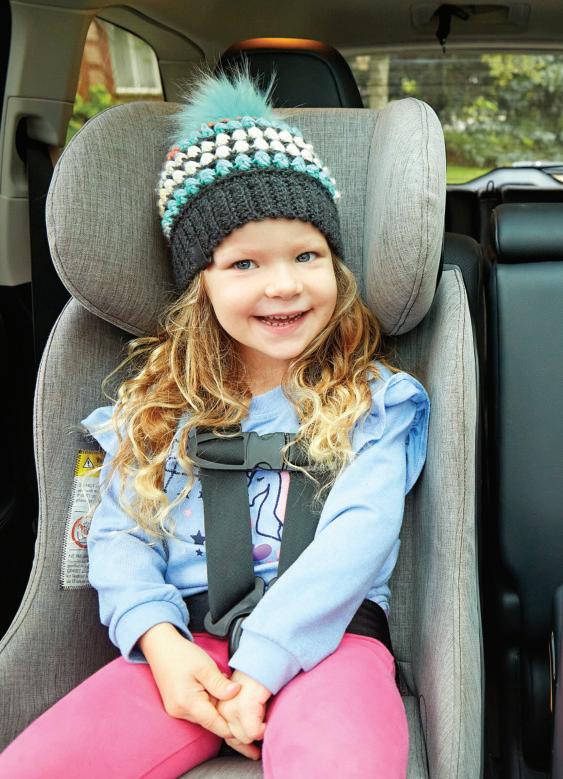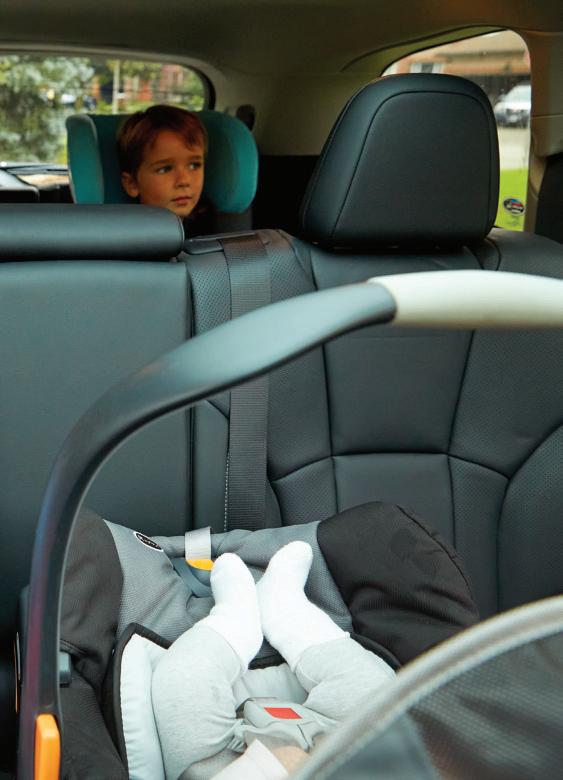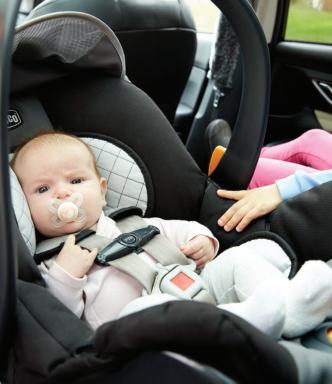
10 minute read
SHOPPING
BUYING G U IDE
HOW TO BUY A CAR SEAT
Advertisement
Shopping for a car seat can be overwhelming with so many models, price points and safety features. Whether you’re in the market for a seat for your babe, toddler or big kid, here’s how to make sure every ride is a safe one.
PPURCHASING THE RIGHT car seat involves striking a balance between your kid, your car and your lifestyle. Depending on your child’s weight and height, your options are infant (or “bucket” seat), convertible and booster. (We’ll talk about all-in-ones, too.) All car seats legally sold in Canada will have the National Safety Mark sticker, which means they’ve been tested and deemed safe. The “safest” car seat for your child is one that is compatible with your vehicle and has been correctly installed.
I N FA N T (O R B U C K E T ) C A R S E AT S
Infant car seats are designed for preemies and babies weighing at least two kilograms (four pounds) and can be used until they reach the seat’s weight or height limits— usually 14 to 16 kilograms (30 to 35 pounds)— or if your baby’s head sits 2.5 cm (1 inch) below the top of the car seat.
Infant car seats are only installed rearfacing, which is the safest position for protecting your baby’s head, neck and back in the case of a sudden stop or collision. Opt for a seat with an easy-to-read recline level indicator—there are a variety of types
2 CONVE RTIBLE CAR SEAT
available, ranging from a simple sticker to a bubble. This will help you to adjust your baby’s car seat to an optimal angle, so their chin stays off their chest, allowing for unobstructed breathing.
No one plans to have a small baby, but the car seat you choose should have features to accommodate one just in case. Look for a seat with a harness that includes a low setting, to create minimal distance between the harness and the crotch buckle, says Katherine Hutka, president of the Child Passenger Safety Association of Canada, health promotion specialist at Child Safety Link and a mom of two.
The harness straps should be at or just below your baby’s shoulders to help prevent them from sliding up toward the top of the car seat in the case of a sudden stop or accident. “We don’t want the straps to be floating up around their ears,” says Hutka. “It puts them at greater risk of injury.”
3 HIGH-BACK
BOOSTE R SEAT
1 INFANT (OR
BUCKET) SEAT

Infant car seats can be installed with the detachable base and carrier using your vehicle’s universa l anchorage system (UAS), but you can also install the carrier on its own using just the seat belt when y ou’r e r u n n i n g a q u ic k e r r a nd i n Grandma’s car, renting a vehicle or hopping in the back of a cab. Since the seat is detachable, you ca n ca rr y your baby around in it or click it into the stroller, when needed.
C O N V E R T I B L E C A R S E AT S
These car seats are typically used the longest, as they’re designed to take children from rear-facing to forward-facing.
Once your child outgrows your ca r seat’s ma ximum rear-facing limitations or weighs at least 10 kilograms (22 pounds) and is at least two years old, you’re able to turn the car seat around so they can ride for ward-facing. But experts like Hutka recommend that children travel rear-facing for as long as possible because it’s the safest position. Depending on the model, some forward-facing car seats are made for children weighing up to 30 kilograms (65 pounds).
If your car’s headrest is interfering with installation, check your manual to see if it is safe to remove. The top of the car seat must rest flush against the seatback. Check with your local retailer or chat with representatives online about store return policies so you can test the features and check for vehicle compatibility. If you can try before you buy, do it.
The five-point harness should be easy to adjust as your little one grows—straps should be positioned at or just above the shoulders so your kid is protected in case of a collision. This will also help them sit straight and tall.
As with infant rear-facing car seats, refer to the manual to see if any recline is allowed. If so, check the angle indicator to ensure your child is angled properly for their weight and height.
Some convertible car seats may boast a steel-reinforced frame, rather than a plastic one, but try not to pit them against each other. “All of the car seats sold in Canada meet incredibly high standards,” says Hutka. “We can’t say one is better than the other. What’s most important is that they’ve all passed rigorous Canadian safety testing.” In other words, it’s your choice, and vehicle compatibility is key.
B O O S T E R S E AT S
Kids can transition to a booster when they’ve outgrown their forward-facing convertible car seat and weigh at least 18 kilograms (40 pounds) and are at least four years old. But behavioural maturity also has a lot to do with whether they’re ready to sit safely in a booster. Kids should be able to sit tall and with their bum at the back of the seat for the entire ride—even when they’re napping. “The seat belt is only going to protect your child if they’re sitting correctly, so they have to be ready,” says Hutka.
If your child has outgrown their current five-point harness seat but isn’t behaviourally ready, she recommends purchasing another five-point harness seat that can hold a taller, heavier kid, which will help prevent them from leaning forward, slouching, unbuckling and grabbing the door handle, for example.
There are three types of boosters: a car seat that converts to a booster, a high-back booster and a backless booster. A properfitting booster is one that comfortably positions your kid’s knees over the edge of the booster and vehicle seat. Experts at Consumer Reports recommend a high-back booster because it offers optimal seat belt posit ioning over your k id’s strongest bones—over the shoulder and in the centre of the collarbone, and across the pelvis (upper thighs). Some models even offer side-impact protection and head support if your kid takes a snooze. The majority of high-back booster models convert to a backless any way, so you can make the adju st ment when you r k id is ready. Backless models are easier to transport from car to car.
B U Y I N G U S E D
A used car seat can be more affordable and convenient than a new one, but only when purchased from a trusted source, like a family member or friend—not from a public marketplace. The car seat is only safe if it’s never been involved in a collision and if it isn’t expired. You can reference the Child Passenger Safety Association’s used car seat checklist to make sure the car seat in question is still safe.
A R E A L L-I N - O N E C A R S E AT S W O R T H I T ?
These car seats are tempting as a money saver since they’re designed to fit children from their infancy to their booster days. The experts at Consumer Reports say these seats are safe—but have some limitations. For example, when your child is an infant, you lose the convenience of being able to carry them around in their bucket carrier or snapping them into your stroller.
Parents tend to favour the infant carrier, Hutka says, since they can buckle up their baby in the house before going out to the car. “You have time, it’s warm and you have ample space,” she says.
Also, as your little one outgrows their for ward-facing convertible days, they might actually be socially and developmentally ready to move on from the car seat they’ve been sitting in for years to a backless booster.
I N S TA L L AT IO N B A S IC S
All vehicles made in Canada after 2002 are equipped with a universal anchorage system (UAS). This means you can install a car seat using the vehicle’s lower anchor bars, which can be found between your vehicle’s seat cushion and seatback. Your owner’s manual will indicate their exact locations.
Never install a car seat in a front seat—the force of passenger airbags c ou ld d a m a ge t he c a r s e a t a nd i nju r e you r c h i ld . C a r s e at s a r e a lways inst a lled in t he back seat where t here’s a shou lder a nd lap seat belt ava ilable.
Need help? Reach out to your manufacturer w ith questions or read reviews from trusted sources like trained car seat technicians. You can also get in touch with a technician virtually or book an appointment to have your seat professionally installed.
G E T T I N G A S E C U R E F I T
Look for features that make it easier for you to adjust the car seat correctly every time, like mechanisms that make tightening a breeze, level indicators that are easy to read for proper angling, and harness designs that make adjustments simpler. Securing or making adjustments to your car seat should be intuitive, but dog-ear important pages in your car seat and vehicle manuals for easy referencing—your future self will thank you.
Safety features are constantly evolving and can vary. Features like built-in seat belt lock-offs are good to have, as they’re designed to hold the seat belt in a fixed spot to help you achieve a tight installation. There are also a variety of types of seat belt lock-offs (levers, latches and clips) and different ways to thread the seat belt based on car seat positioning—refer to your car seat’s manual for when and how to use them.
You’ll know you’ve got a secure fit in either a rear-facing or forward-facing position by grabbing both sides of the car seat where it’s attached to the car and, with the strength of a firm handshake, giving it a good tug from side to side and front to back—it shouldn’t wiggle more than 2.5 cm (1 inch). —Linda Nguyen

Best practices
Five ways to ensure a safe and smooth install.
If you can, try before you buy. Some car seats fi t be er in some vehicles than others. There are many diff erent variables when it comes to achieving a good, secure fi t. Try a fl oor model, if possible. Many retailers don’t allow returns on car seats. Purchase within your budget. A pricier car seat with the latest, most innovative features doesn’t make it more safe. If it’s not a good fi t with your vehicle or you can’t get a proper install, it’s not going to keep your child safe. Look for the National Safety Mark; it’s proof that the car seat meets Canadian safety standards. Register your car seat. When it comes to your kid’s safety, be the fi rst to know if something is wrong. Manufacturers will only use your information to contact you in case of defects or recalls. If you purchase used, re-register the car seat under your name. Read the manuals. Become familiar with your car seat’s manual and your vehicle’s manual so you understand their capabilities. This will make installation and adjustments easier. Research extras. Experts advise against using a er-market products, like harness pads, car seat covers or seat protectors, because these items could change how your car seat performs in a crash.










